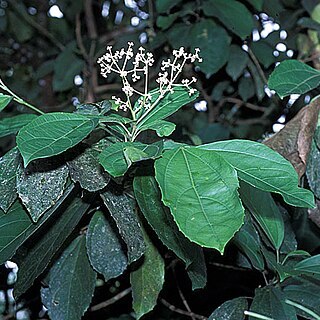beneath, the network of the veins prominulous below. Inflorescences usually large and many-flowered, the axes puberulous. Flowers greenish, yellowish-white or white, the pedicels slender, to 1 cm long, puberulous to tomentellous; sepals 4, reflexed, ovate, acute, to 2.8 mm long and 1.3-1.7 mm wide, puberulous to tomentel-lous; petals 4, reflexed, obovate, acute, to 2.7 mm long and 1.2-1.4 mm wide, puberulous to tomentellous; stamens 30-40, inserted on a glandular disc (apparently 8 separate glands), the filaments 3-4 mm long, puberulous to sparsely puberulous, the anthers ca 0.25-0.3 mm long; ovary substipitate, globose-ellipsoid, ca 1.5-1.8 mm long and 1.3-1.5 mm wide, puberulous to subglabrous, the style ca 1.5-2 mm long. Bacca subglobose, surmounted by the persistent style, 4-6 mm long, the pericarp succulent, red to black, puberulous, becoming glabrous; seeds 1 or 2, 3.5-4.5 mm long, the testa glabrous.
More
Shrub or small tree 3-10 m high, the trunk to 30 cm in diam, the branchlets glabrous or appressed-puberulous. Leaves dark green, with the petioles to 4 cm long, canaliculate above, glabrous or appressed-puberulous; blade from narrowly to broadly-elliptic, sometimes oblong-elliptic, acute at the base, obtusely acuminate at the apex, coarsely and irregularly serrate along the margins, to 22.5 cm long and 11 cm wide, chartaceous, glabrous above, glabrous or appressed-puberulous especially along the veins below, the main veins and secondary veins prominent
Dense primary forest, more commonly in more open secondary formations, forest edges and roadsides. Dry loam in old clearings, sometimes forming undergrowth in moderately dense forest free from periodical inundations, to 1,400 metres.


